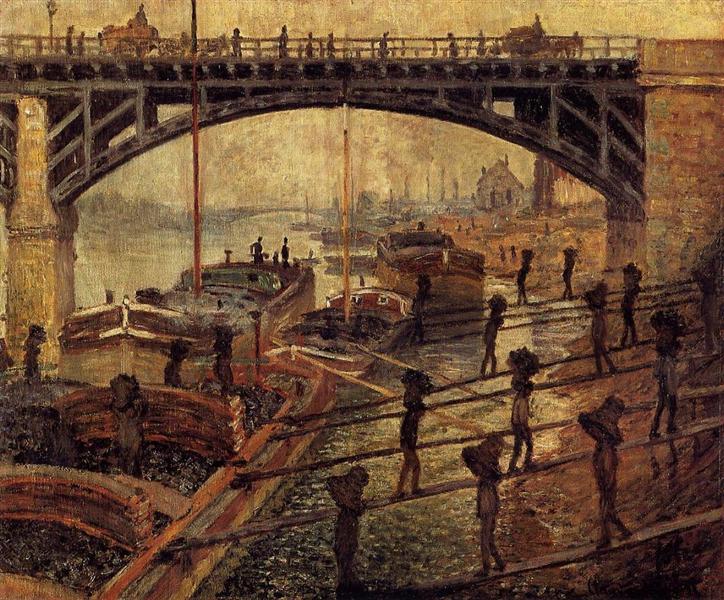Description
Claude Monet's "coal docker", made in 1875, stands as a moving and vibrant testimony of the industrial environment of the nineteenth century. Monet, one of the founders of impressionism, offers on this canvas a clear manifestation of his talent to capture light and atmosphere, infusing a dynamic life in a daily moment that, otherwise, could have been considered mundane. The painting portrays a group of stibisters on a coal spring, involved in a laborious activity that reveals both the energy of the scene and the dignity of manual work.
In the composition, the stibisters are presented in an organized dynamic, in the process of moving huge bags of coal. His disposition and the direction of his movement create a feeling of simultaneity, of action. The characters are not portrayed with an individualized approach; Instead, they are collective representations of human effort. This approach resonates with the impressionist philosophy that sought to capture the visual experience in its purest state, leaving aside the traditional narratives to focus on the perception and the present moment.
The color palette used by Monet is distinctive and effective. The dark tones of coal contrast with the clearings of the sky and the light that filters in the scene. This game of lights and shadows not only establishes a spatial sense, but also evokes the emotions associated with hard work and industrial atmosphere. Monet, through its rapid brushstroke technique and its ability to mix colors on the canvas, manages to transmit the vibrant energy of the environment, suggesting the movement and sound of men working.
The clouds that wrap the sky and the diffuse sunlight that is filtered through them are not mere background elements; They are, in a way, actors of the scene itself, contributing to an atmosphere that can be both oppressive and liberating. In this work, Monet combines the air of romanticism in the representation of nature with the clear influence of modern life. The image of the dockers is both a representation of their work, as a reflection on the imminent change that the industrial revolution brought to society.
The painting is in a work line that documes the way of life of its time, similar to others paintings of Monet that also portray industrial work and daily life in the urban context, such as the scenes of the series of the Rouen docks, where light plays a fundamental role in the transformation of the industrial landscape. "Coal dockers" stands out not only for its theme, but also for being a clear example of the boom of impressionism, which departed from the previous academic conventions and embraced the immediacy of visual experience.
In addition, this piece highlights Monet's interest in the representation of social and economic transformation, pointing out how the industry began to mold the environment and life of people. When looking at this work, spectators are invited to reflect not only on stibisters and their task, but also on the impact of industrial progress on humanity. In its representation, Monet captures the essence of the moment, erecting a bridge between the everyday and the sublime, which allows the work to resonate both in its time and today. Thus, "coal dockers" becomes a fundamental work in the study of the transition towards modernity in painting, offering a look at the rich interaction between humans and its industrial environment.
KUADROS ©, a famous paint on your wall.
Hand-made oil painting reproductions, with the quality of professional artists and the distinctive seal of KUADROS ©.
Reproduction service paintings With a guarantee of satisfaction. If you are not completely satisfied with the replica of your painting, we refund your money 100%.

